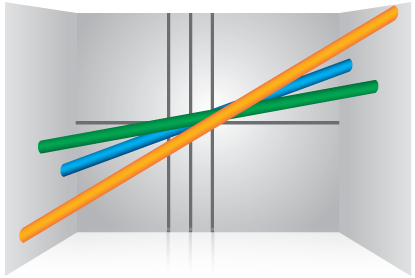Monitoring & Analysis
We break down every piece of the savings puzzle
At PES, we concentrate on gathering extensive data by closely monitoring the facility. Instead of relying on customer interviews for approximate run times and occupancy schedules, we obtain actual hours of use and time of day occupancy, showing how much energy can be saved and when. Our analysts distinguish between specific area types and the total building data to provide a statistically relevant and accurate diagnosis.
Our audit team installs the monitoring system in the facility. Each room is assigned an area type; rooms of the same area type are blended together to simulate actual usages of that type of room. Additionally, the lighting loads are considered to establish an overall usage of the entire facility. Upon completion of the monitoring, our professionals collect, analyze, and produce a comprehensive savings report that includes real time hours of operation, peak billing hours and a summary of the project.
Our analysts take everything into consideration, including a time of day connected load before and after the project, load by area type, energy consumption by area type and electrical demand by area type. In doing so we can evaluate energy savings, simple payback, return on investment, cash flow, and environmental impact.
 Math
Math [ ( Lighting Savings + % of Combined ) + ( Sensor Savings + % of Combined ) = Total Savings ]
[ ( Lighting Savings + % of Combined ) + ( Sensor Savings + % of Combined ) = Total Savings ]When it comes to determining the savings between lighting and sensor payback, most calculations are confusing and inaccurate. At PES, we break down each piece of the ‘savings’ puzzle to unearth the best possible combined payback and to make it as clear as possible to our customers.


Lighting:
Lighting upgrades reduce the kilowatt Load of the facility.
Controls:
Installing sensor controls reduce the hours of usage of the facility’s lighting.
Controls & Lighting:
A comprehensive retrofit does BOTH. When allocating the savings from each measure, we recognize the effect of reducing the load while simultaneously turning it off.
 Contact Term Cash Flow vs. Payback
Contact Term Cash Flow vs. Payback

-
Lighting:
Lighting typically has a longer payback then Occupancy Sensors, historically providing greater Contract Term Cash Flow.

-
Controls:
Occupancy Sensors which typically provide the best payback, historically provide less Contract Term Cash Flow.

-
Combined:
Combining both measures increases the payback, historically providing the maximum Contract Term Cash Flow.mm
 ( Lighting Savings + Controls Savings = Combined Savings )
( Lighting Savings + Controls Savings = Combined Savings )